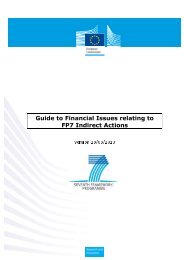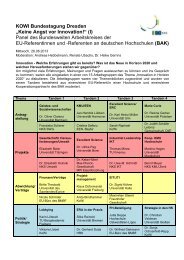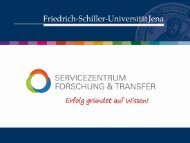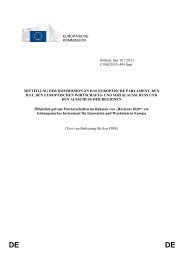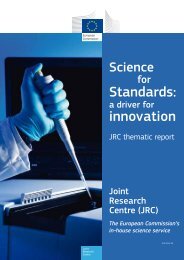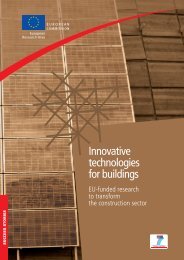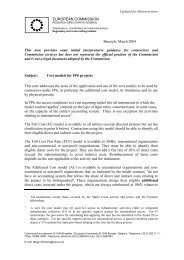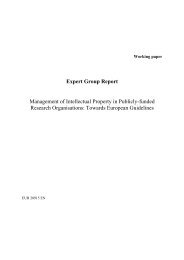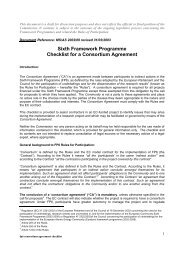Joint Ownership in Intellectual Property Rights - KoWi
Joint Ownership in Intellectual Property Rights - KoWi
Joint Ownership in Intellectual Property Rights - KoWi
You also want an ePaper? Increase the reach of your titles
YUMPU automatically turns print PDFs into web optimized ePapers that Google loves.
The IPR-Helpdesk is a project of the European Commission DG Enterprise,<br />
co-f<strong>in</strong>anced with<strong>in</strong> the fifth framework programme of the European Community<br />
3.3 German patent law<br />
Accord<strong>in</strong>g to § 6 of the German patent law, it is not the first applicant but the <strong>in</strong>ventor who is entitled to the patent. Nevertheless,<br />
German patent law has <strong>in</strong>troduced a "first to file" system <strong>in</strong> contrast to the "first to <strong>in</strong>vent" system <strong>in</strong> US patent law: If<br />
the same <strong>in</strong>vention is made by different <strong>in</strong>vertors at the same time, only the one who applies first is entitled to the patent. So<br />
there is no <strong>Jo<strong>in</strong>t</strong> <strong>Ownership</strong> <strong>in</strong> this case.<br />
Under German patent law, the <strong>in</strong>ventor has to be a natural person. Co-<strong>in</strong>ventors are both entitled to the patent (§ 6,2). Co<strong>in</strong>vention<br />
arises from the collaboration of two or more natural persons and requires substantial contributions. Co-<strong>in</strong>ventorship<br />
leads to questions regard<strong>in</strong>g the <strong>in</strong>ventor's moral rights as well as entitlement to the patent:<br />
- Every <strong>in</strong>ventor acquires moral rights to the <strong>in</strong>vention, which are basically the right to be named as the <strong>in</strong>ventor by the<br />
applicant (§ 37) and <strong>in</strong> the patent specification and publication.<br />
- All co-<strong>in</strong>ventors are entitled to the patent and therefore form a <strong>Jo<strong>in</strong>t</strong> <strong>Ownership</strong>. The legal relationship among co<strong>in</strong>ventors<br />
is determ<strong>in</strong>ed by themselves via contract agreements and can lead to a legal entity on a contractual basis<br />
(Gesellschaft bürgerlichen Rechts, §§ 705 ff. BGB). In the absence of any agreement to the contrary, the effect of<br />
<strong>Jo<strong>in</strong>t</strong> <strong>Ownership</strong> is to create a legal entity that shares undivided <strong>in</strong>terests <strong>in</strong> the <strong>in</strong>tellectual property right - i.e. each<br />
party holds a nom<strong>in</strong>al equal share, simply divided per head (Bruchteilsgeme<strong>in</strong>schaft, §§ 741 ff BGB). Each jo<strong>in</strong>t<br />
owner can assign his <strong>in</strong>terest to a third party and this party will then replace the former jo<strong>in</strong>t owner with respect to the<br />
<strong>in</strong>terest. Any deal<strong>in</strong>g on the patent itself is subject to consent. In the case of a parties' death, his <strong>in</strong>terest will pass to<br />
the others. In the case of the <strong>in</strong>solvency of a jo<strong>in</strong>t owner, his <strong>in</strong>terest can be transferred to creditors.<br />
Specific regulations exist on <strong>in</strong>ventions made by employees us<strong>in</strong>g the knowledge ga<strong>in</strong>ed from their specific job occupation<br />
or the material provided. The employee has to report the <strong>in</strong>vention to his employer. The employer can then opt<br />
to make use of the <strong>in</strong>vention and reimburse the employee.<br />
3.4 Italian patent law<br />
Article 20 of the Italian Patent Law states that when an <strong>in</strong>vention is made by the collaboration of various authors (<strong>in</strong> the absence<br />
of an agreement between the parties), the Italian Civil Code concern<strong>in</strong>g Community will apply. It has to be highlighted<br />
that this k<strong>in</strong>d of regulation is provided for tangible assets and not for <strong>in</strong>tangible ones, with the consequent problems of adaptation.<br />
Under Article 1105 of the Italian Civil Code, the majority of co-owners can claim protection. This is a problematic issue to<br />
regulate, as many decisions that have to be taken <strong>in</strong> order to obta<strong>in</strong> patent protection: The date of fill<strong>in</strong>g, the legal patent<br />
system, the patent attorney, etc. The right to claim for patent protection belongs to all co-authors.<br />
Co-authors are the members of the group that developed the research activity result<strong>in</strong>g <strong>in</strong> the patent, and this excludes others<br />
that developed other research activities or executed simple tasks. All the co-authors have the same share under Article<br />
1101 of the Italian Civil Code.<br />
Under Article 732 of the Italian Civil Code, every co-owner is free to transfer his share, but the other co-owners have an exclusive<br />
right to buy it.<br />
Follow<strong>in</strong>g the regime of the Italian Civil Code on Community, it could be affirmed that the <strong>Jo<strong>in</strong>t</strong> <strong>Ownership</strong> and exploitation of<br />
the patent rights belong<strong>in</strong>g to various persons apply pro <strong>in</strong>diviso (<strong>in</strong> undivided parts).<br />
The regulation of this issue <strong>in</strong> the Italian patent system thus provides that the <strong>Jo<strong>in</strong>t</strong> <strong>Ownership</strong> of patent rights will be governed<br />
by:<br />
- The agreement between the parties<br />
- In its absence: The Civil Law provisions on <strong>Jo<strong>in</strong>t</strong> <strong>Ownership</strong> (Civil Code).<br />
In what cases can <strong>Jo<strong>in</strong>t</strong> <strong>Ownership</strong> of patent rights arise?<br />
Accord<strong>in</strong>g to Section 2 of the fifth book of the Italian Civil Code, the patent right belongs to the <strong>in</strong>ventor. So the first, and simplest,<br />
case of <strong>Jo<strong>in</strong>t</strong> <strong>Ownership</strong> is where various <strong>in</strong>ventors collaborate to make the same <strong>in</strong>vention. The <strong>in</strong>ventors can jo<strong>in</strong>tly<br />
apply for a patent and will be its jo<strong>in</strong>t owners. A second possibility is where one <strong>in</strong>ventor transfers his rights to more than one<br />
person. The transferees will also be jo<strong>in</strong>t owners of the patent, without be<strong>in</strong>g its <strong>in</strong>ventors, and the related provisions will apply<br />
to them.<br />
Although it is the common way, the patent does not have to be registered <strong>in</strong> all of the co-<strong>in</strong>vertors' names. In any event, the<br />
co-<strong>in</strong>ventors have the right to be designated as such but can decide that the patent is to be registered to only one co<strong>in</strong>ventor.<br />
If the patent rights are transferred and the patent owner is not the <strong>in</strong>ventor, the latter has the right to be mentioned<br />
as such under Article 23 <strong>in</strong> respect of service <strong>in</strong>ventions.<br />
Accord<strong>in</strong>g to Article 1102 of the Italian Civil Code, one of the jo<strong>in</strong>t owners is free to exploit the <strong>in</strong>vention alone but only <strong>in</strong>sofar<br />
as the jo<strong>in</strong>t owner's exploitation does not cause damage to the community's <strong>in</strong>terests or prevent other jo<strong>in</strong>t owners from<br />
exploit<strong>in</strong>g the patent.<br />
3.5 Spanish patent law<br />
Section 10 paragraph 2 of the Spanish Patent and Utility Models Law states that when an <strong>in</strong>vention is made by the collabo-<br />
- 13 -



